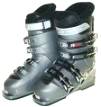|
The Feel-Good Guide to Sports, Travel, Shopping & Entertainment
|
||
| Main | Sports Events | Holidays & Observances | Pop Culture | Shopping | Travel |
|
Main Ski Boots -- Testing 1,2,3 Since the initiation of the turn starts with the foot, and the foot rests inside the boot, everything depends on the right fit. If your boots are uncomfortable, don't flex adequately, or your feet are out of alignment, your performance and technique will be adversely affected. In addition, foot comfort and alignment are critical for skiers, since they affect the ability to maintain a balanced stance. Softer Ski Boots for Shaped Skis
With regards to the aspiring all-terrain skier who has recently purchased shaped skis or is contemplating a new pair of super side-cuts, we'll take a look at a number of different manufacturers and models in a future article. The ski boots we examine will be geared to the expert skier. First, we'll cover the following topics:
For those who are happy with their straight-sided or subtle side-cut skis, and conventional ski boots, please stay with us especially if you are having trouble with your boots in terms of fit, comfort, or stiffness. You may just need an external flex adjustment, an internal modification to eliminate a pressure point, or a foot bed to replace the original insole that came with your ski boots.
To test if you have a problem with your stance, stand in front of a mirror and slowly bring your legs together.
A sporting goods store sells all types of equipment, whereas a ski shop specializes in ski equipment and clothes in the fall and winter months. A good ski shop will have trained and experienced ski boot fitters on staff. If you can't find such a store locally, drive to the nearest town or city which has a shop suited to your needs. Comfort and Performance Once inside the ski shop, prepare to spend three to four hours for a proper fit. Yes, three to four hours! You'll be wearing the boots for the next five to ten years, so it's imperative that you spend the time initially to get the best fit. As an aspiring expert, you want the best fit possible, so you can reap the best of both worlds. You need to strike a balance between comfort and performance.
In terms of comfort, the expert skier needs a boot that he or she buckles up in the morning, and rarely needs to adjust throughout the day. There should be no pain, pinching, or pressure points, and your feet should never get numb or cold. The fit should be so good that you don't mind leaving them tightened up during your lunch break. In terms of
performance, aspiring experts need boots that they hardly know
they are wearing. The boot should feel like an extension of the
foot. When you roll your ankle and foot, even slightly, you should
get a lightning fast response from the inside of the boot to the
edge of the ski. The time lag should be minimal. About the Author... Jim Safianuk is a certified ski instructor and writer of the downhill skiing lessons in the course Skills of the Expert Skier.
Ski Boots - How to Find a Good Fit
|
 With the advent of shaped skis, subtle foot-and-ankle steering has almost replaced the need to apply strong forward pressure to the tips of the skis. To compensate, boot manufacturers began to make ski boots with more natural flex built right into the design. The result is a softer more comfortable ski boot, with better handling characteristics.
With the advent of shaped skis, subtle foot-and-ankle steering has almost replaced the need to apply strong forward pressure to the tips of the skis. To compensate, boot manufacturers began to make ski boots with more natural flex built right into the design. The result is a softer more comfortable ski boot, with better handling characteristics.
